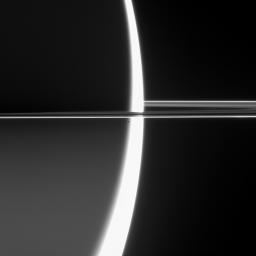A Captivating Vision
Caption:
Cassini captured this arresting view of Saturn just before Epimetheus crossed into the blinding glare of the planet's sunlit crescent and was lost.
As it orbits Saturn, Epimetheus (116 kilometers, or 72 miles across) hugs the outside edge of the narrow F ring, beyond the orbit of Pandora. The F ring is the brightest ring feature seen here. Saturn's southern hemisphere is softly lit by sunlight reflected off the rings.
A less obvious feature in this view is the planet's shadow, which begins to darken the inner regions of the rings at left.
The image was taken in visible light with the Cassini spacecraft narrow-angle camera on June 9, 2006 at a distance of approximately 4 million kilometers (2.5 million miles) from Epimetheus and 4.1 million kilometers (2.5 million miles) from Saturn. The Sun-Epimetheus-spacecraft, or phase, angle is 161 degrees. Image scale is 25 kilometers (16 miles) per pixel on Saturn.
Background Info:
The Cassini-Huygens mission is a cooperative project of NASA, the European Space Agency and the Italian Space Agency. The Jet Propulsion Laboratory, a division of the California Institute of Technology in Pasadena, manages the mission for NASA's Science Mission Directorate, Washington, D.C. The Cassini orbiter and its two onboard cameras were designed, developed and assembled at JPL. The imaging operations center is based at the Space Science Institute in Boulder, Colo.
For more information about the Cassini-Huygens mission visit
http://saturn.jpl.nasa.gov/home/index.cfm
. The Cassini imaging team homepage is at
http://ciclops.org
.
Cataloging Keywords:
| Name |
Value |
Additional Values |
| Target |
Saturn Rings |
Epimetheus, F Ring, Pandora, Saturn |
| System |
Saturn |
|
| Target Type |
Ring |
Planet, Satellite |
| Mission |
Cassini-Huygens |
|
| Instrument Host |
Cassini Orbiter |
|
| Host Type |
Orbiter |
|
| Instrument |
Imaging Science Subsystem (ISS) |
|
| Detector |
Narrow Angle Camera |
|
| Extra Keywords |
Grayscale, Shadow, Visual |
| Acquisition Date |
|
| Release Date |
2006-07-11 |
| Date in Caption |
2006-06-09 |
|
| Image Credit |
NASA/JPL/Space Science Institute |
| Source |
photojournal.jpl.nasa.gov/catalog/PIA08218 |
| Identifier |
PIA08218 |

 Planetary Data System
Planetary Data System
